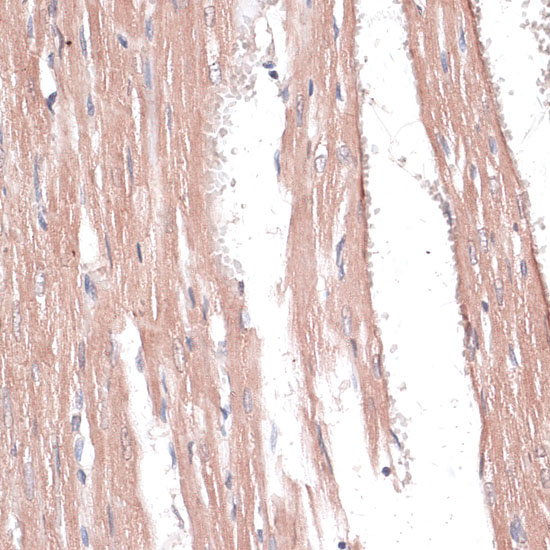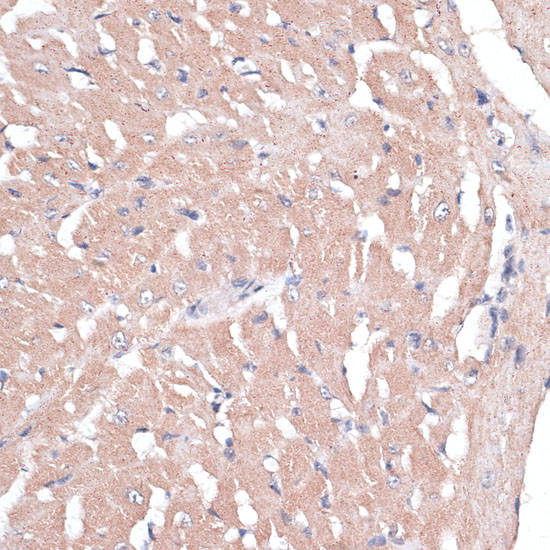Cell Biology Antibodies 2
Anti-COL11A1 Antibody (CAB10559)
- SKU:
- CAB10559
- Product Type:
- Antibody
- Reactivity:
- Mouse
- Reactivity:
- Rat
- Host Species:
- Rabbit
- Isotype:
- IgG
- Antibody Type:
- Polyclonal Antibody
- Research Area:
- Cell Biology
Description
| Antibody Name: | Anti-COL11A1 Antibody |
| Antibody SKU: | CAB10559 |
| Antibody Size: | 20uL, 50uL, 100uL |
| Application: | IHC |
| Reactivity: | Mouse, Rat |
| Host Species: | Rabbit |
| Immunogen: | Recombinant fusion protein containing a sequence corresponding to amino acids 260-430 of human COL11A1 (NP_542196.2). |
| Application: | IHC |
| Recommended Dilution: | IHC 1:50 - 1:200 |
| Reactivity: | Mouse, Rat |
| Positive Samples: |
| Immunogen: | Recombinant fusion protein containing a sequence corresponding to amino acids 260-430 of human COL11A1 (NP_542196.2). |
| Purification Method: | Affinity purification |
| Storage Buffer: | Store at -20'C. Avoid freeze / thaw cycles. Buffer: PBS with 0.02% sodium azide, 50% glycerol, pH7.3. |
| Isotype: | IgG |
| Sequence: | EKKK SNFK KKMR TVAT KSKE KSKK FTPP KSEK FSSK KKKS YQAS AKAK LGVK ANIV DDFQ EYNY GTME SYQT EAPR HVSG TNEP NPVE EIFT EEYL TGED YDSQ RKNS EDTL YENK EIDG RDSD LLVD GDLG EYDF YEYK EYED KPTS PPNE EFGP GVPA ETDI TETS ING |
| Gene ID: | 1301 |
| Uniprot: | P12107 |
| Cellular Location: | Secreted, extracellular matrix, extracellular space |
| Calculated MW: | 167kDa/176kDa/181kDa/182kDa |
| Observed MW: | Refer to figures |
| Synonyms: | COL11A1, CO11A1, COLL6, STL2 |
| Background: | This gene encodes one of the two alpha chains of type XI collagen, a minor fibrillar collagen. Type XI collagen is a heterotrimer but the third alpha chain is a post-translationally modified alpha 1 type II chain. Mutations in this gene are associated with type II Stickler syndrome and with Marshall syndrome. A single-nucleotide polymorphism in this gene is also associated with susceptibility to lumbar disc herniation. Multiple transcript variants have been identified for this gene. |
| UniProt Protein Function: | COL11A1: May play an important role in fibrillogenesis by controlling lateral growth of collagen II fibrils. Defects in COL11A1 are the cause of Stickler syndrome type 2 (STL2); also known as Stickler syndrome vitreous type 2. STL2 is an autosomal dominant form of Stickler syndrome, an inherited disorder that associates ocular signs with more or less complete forms of Pierre Robin sequence, bone disorders and sensorineural deafness. Ocular disorders may include juvenile cataract, myopia, strabismus, vitreoretinal or chorioretinal degeneration, retinal detachment, and chronic uveitis. Robin sequence includes an opening in the roof of the mouth (a cleft palate), a large tongue (macroglossia), and a small lower jaw (micrognathia). Bones are affected by slight platyspondylisis and large, often defective epiphyses. Juvenile joint laxity is followed by early signs of arthrosis. The degree of hearing loss varies among affected individuals and may become more severe over time. Syndrome expressivity is variable. Defects in COL11A1 are the cause of Marshall syndrome (MRSHS). It is an autosomal dominant disorder characterized by ocular abnormalities, deafness, craniofacial anomalies, and anhidrotic ectodermal dysplasia. Clinical features include short stature; flat or retruded midface with short, depressed nose, flat nasal bridge and anteverted nares; cleft palate with or without the Pierre Robin sequence; appearance of large eyes with ocular hypertelorism; cataracts, either congenital or juvenile; esotropia; high myopia; sensorineural hearing loss; spondyloepiphyseal abnormalities; calcification of the falx cerebri; ectodermal abnormalities, including defects in sweating and dental structures. Defects in COL11A1 are the cause of fibrochondrogenesis type 1 (FBCG1). A severe short-limbed skeletal dysplasia characterized by broad long-bone metaphyses, pear-shaped vertebral bodies, and characteristic morphology of the growth plate, in which the chondrocytes have a fibroblastic appearance and there are regions of fibrous cartilage extracellular matrix. Clinical features include a flat midface with a small nose and anteverted nares, significant shortening of all limb segments but relatively normal hands and feet, and a small bell-shaped thorax with a protuberant abdomen. Belongs to the fibrillar collagen family. 3 isoforms of the human protein are produced by alternative splicing. |
| UniProt Protein Details: | Protein type:Secreted, signal peptide; Extracellular matrix; Secreted Chromosomal Location of Human Ortholog: 1p21 Cellular Component: collagen type XI; endoplasmic reticulum lumen; extracellular region Biological Process: collagen catabolic process; detection of mechanical stimulus involved in sensory perception of sound; sensory perception of sound; visual perception Disease: Fibrochondrogenesis 1; Intervertebral Disc Disease; Marshall Syndrome; Stickler Syndrome, Type Ii |
| NCBI Summary: | This gene encodes one of the two alpha chains of type XI collagen, a minor fibrillar collagen. Type XI collagen is a heterotrimer but the third alpha chain is a post-translationally modified alpha 1 type II chain. Mutations in this gene are associated with type II Stickler syndrome and with Marshall syndrome. A single-nucleotide polymorphism in this gene is also associated with susceptibility to lumbar disc herniation. Multiple transcript variants have been identified for this gene. [provided by RefSeq, Nov 2009] |
| UniProt Code: | P12107 |
| NCBI GenInfo Identifier: | 215274245 |
| NCBI Gene ID: | 1301 |
| NCBI Accession: | P12107.4 |
| UniProt Secondary Accession: | P12107,Q14034, Q149N0, Q9UIT4, Q9UIT5, Q9UIT6, B1ASK7 D3DT73, E9PCU0, |
| UniProt Related Accession: | P12107 |
| Molecular Weight: | 167,752 Da |
| NCBI Full Name: | Collagen alpha-1(XI) chain |
| NCBI Synonym Full Names: | collagen type XI alpha 1 chain |
| NCBI Official Symbol: | COL11A1 |
| NCBI Official Synonym Symbols: | STL2; COLL6; CO11A1 |
| NCBI Protein Information: | collagen alpha-1(XI) chain |
| UniProt Protein Name: | Collagen alpha-1(XI) chain |
| Protein Family: | Collagen |
| UniProt Gene Name: | COL11A1 |
| UniProt Entry Name: | COBA1_HUMAN |
View AllClose








